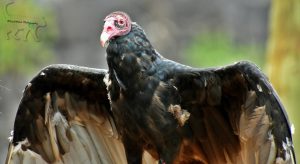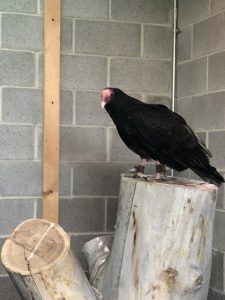Turkey Vulture (Catharates aura)
Taxonomy
Kingdom: Animalia
Phylum: Chordata
Class: Aves
Order: Falconiformes
Family: Cathartidae
Genus: Cathartes
Species: Catharates aura
Conservation Status in Idaho
Demonstrably widespread, abundant, and secure, breeding population.
US Migratory Bird Act
Protected
Range and Habitat
The turkey vulture is found from the southern border of Canada to the southern tip of Chile. They occupy a diverse range of habitat from forests to open environments.
Physical Features
Weight: 1.9–4.4 lbs (0.85–2.0 kg)
Length: 25–32 in (64–81 cm)
Wingspan: 67–72 in (170–183 cm)
There are six subspecies of turkey vulture that vary in size. Male and female do not differ. Turkey vultures have brownish black plumage with a bare neck and head. The color of head and neck varies from pink to bright red.
Diet
Carrion
Lifespan
Up to 17 years in the wild and slightly longer in captivity.
Reproduction
Breeding occurs from March to June in North America. Turkey vultures participate in courtship rituals that involve several birds on the ground hopping in a circle with wings partially spread. During flight a male might follow closely flapping wings and diving. Turkey vulture are monogamous with the pair-bond lasting through the breeding season and sometimes all year. No nest is built instead eggs on bare surfaces in protected locations such as cliffs, caves, rock crevices, burrows, and inside hollow trees. One to three, with two being common, eggs are laid. Both parents incubate and feed. Chicks are hatched between 30 to 40 days, fledged within 10 to 11 weeks, and remain with the group until fall.
Social Behavior and Interaction
Turkey vultures are gregarious roosting in larger groups but search for food independently during the day. Northern populations migrate during the winter. Turkey vultures do have home ranges that vary in size depending on the availability of food. The home ranges are not defended. Turkey vultures have a keen sense of smell that is used along with eye sight to locate carcasses. As a defensive mechanism they will regurgitate semi-digested meat that is foul smelling and contains stomach acid that can sting potential predators if it gets on their face and eyes. To cool down turkey vultures will defecate on their legs, using the evaporation of the water in the feces.
Major Threats
Poison in carcasses, lead, vehicle collision, electrocution from power line strikes, starvation due to immediate removal of carcasses especially along roadways, and persecution due to cultural superstitions.


